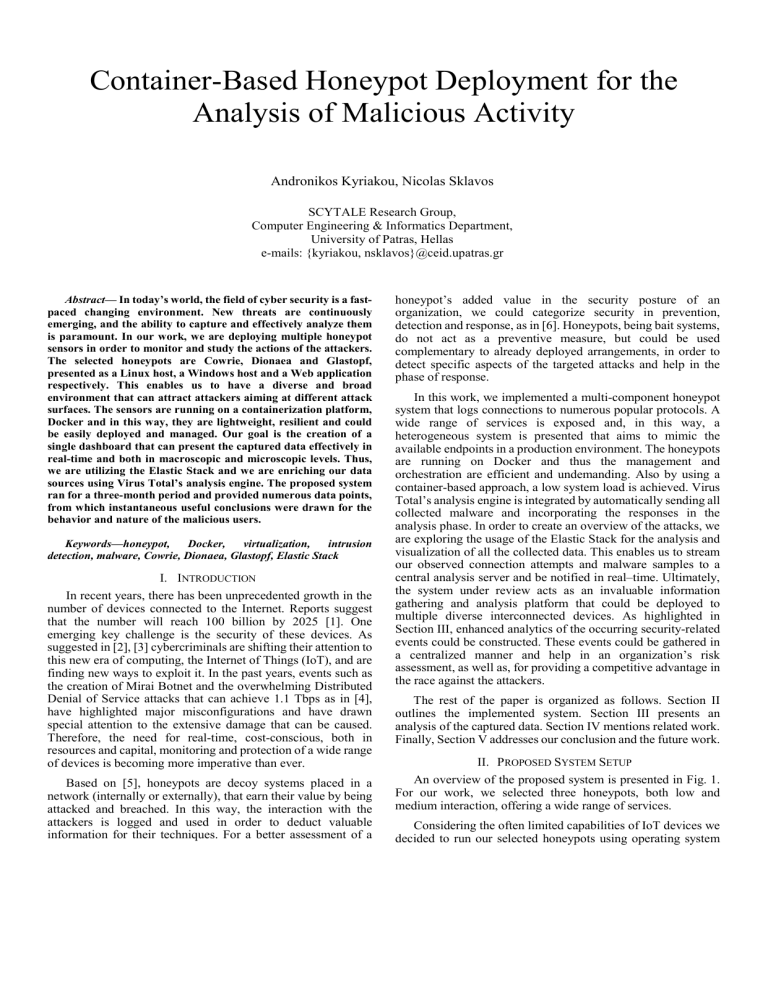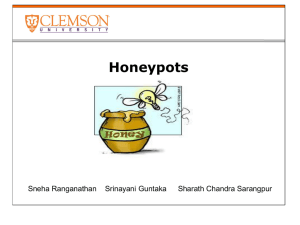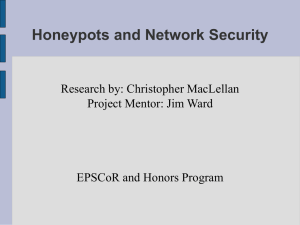
Container-Based Honeypot Deployment for the
Analysis of Malicious Activity
Andronikos Kyriakou, Nicolas Sklavos
SCYTALE Research Group,
Computer Engineering & Informatics Department,
University of Patras, Hellas
e-mails: {kyriakou, nsklavos}@ceid.upatras.gr
Abstract— In today’s world, the field of cyber security is a fastpaced changing environment. New threats are continuously
emerging, and the ability to capture and effectively analyze them
is paramount. In our work, we are deploying multiple honeypot
sensors in order to monitor and study the actions of the attackers.
The selected honeypots are Cowrie, Dionaea and Glastopf,
presented as a Linux host, a Windows host and a Web application
respectively. This enables us to have a diverse and broad
environment that can attract attackers aiming at different attack
surfaces. The sensors are running on a containerization platform,
Docker and in this way, they are lightweight, resilient and could
be easily deployed and managed. Our goal is the creation of a
single dashboard that can present the captured data effectively in
real-time and both in macroscopic and microscopic levels. Thus,
we are utilizing the Elastic Stack and we are enriching our data
sources using Virus Total’s analysis engine. The proposed system
ran for a three-month period and provided numerous data points,
from which instantaneous useful conclusions were drawn for the
behavior and nature of the malicious users.
Keywords—honeypot,
Docker,
virtualization,
intrusion
detection, malware, Cowrie, Dionaea, Glastopf, Elastic Stack
I. INTRODUCTION
In recent years, there has been unprecedented growth in the
number of devices connected to the Internet. Reports suggest
that the number will reach 100 billion by 2025 [1]. One
emerging key challenge is the security of these devices. As
suggested in [2], [3] cybercriminals are shifting their attention to
this new era of computing, the Internet of Things (IoT), and are
finding new ways to exploit it. In the past years, events such as
the creation of Mirai Botnet and the overwhelming Distributed
Denial of Service attacks that can achieve 1.1 Tbps as in [4],
have highlighted major misconfigurations and have drawn
special attention to the extensive damage that can be caused.
Therefore, the need for real-time, cost-conscious, both in
resources and capital, monitoring and protection of a wide range
of devices is becoming more imperative than ever.
Based on [5], honeypots are decoy systems placed in a
network (internally or externally), that earn their value by being
attacked and breached. In this way, the interaction with the
attackers is logged and used in order to deduct valuable
information for their techniques. For a better assessment of a
honeypot’s added value in the security posture of an
organization, we could categorize security in prevention,
detection and response, as in [6]. Honeypots, being bait systems,
do not act as a preventive measure, but could be used
complementary to already deployed arrangements, in order to
detect specific aspects of the targeted attacks and help in the
phase of response.
In this work, we implemented a multi-component honeypot
system that logs connections to numerous popular protocols. Α
wide range of services is exposed and, in this way, a
heterogeneous system is presented that aims to mimic the
available endpoints in a production environment. The honeypots
are running on Docker and thus the management and
orchestration are efficient and undemanding. Also by using a
container-based approach, a low system load is achieved. Virus
Total’s analysis engine is integrated by automatically sending all
collected malware and incorporating the responses in the
analysis phase. In order to create an overview of the attacks, we
are exploring the usage of the Elastic Stack for the analysis and
visualization of all the collected data. This enables us to stream
our observed connection attempts and malware samples to a
central analysis server and be notified in real–time. Ultimately,
the system under review acts as an invaluable information
gathering and analysis platform that could be deployed to
multiple diverse interconnected devices. As highlighted in
Section III, enhanced analytics of the occurring security-related
events could be constructed. These events could be gathered in
a centralized manner and help in an organization’s risk
assessment, as well as, for providing a competitive advantage in
the race against the attackers.
The rest of the paper is organized as follows. Section II
outlines the implemented system. Section III presents an
analysis of the captured data. Section IV mentions related work.
Finally, Section V addresses our conclusion and the future work.
II. PROPOSED SYSTEM SETUP
An overview of the proposed system is presented in Fig. 1.
For our work, we selected three honeypots, both low and
medium interaction, offering a wide range of services.
Considering the often limited capabilities of IoT devices we
decided to run our selected honeypots using operating system
Lastly, we created yet another tool to query the aforementioned
database and convert the data to JSON format. All the above
scripts, as well as the destruction and recreation of the containers
using Docker Compose, were run periodically using cron jobs.
Fig. 1. Architecture of the Proposed System Setup
level virtualization, also known as containerization. A container
is an isolated virtual environment that packages together an
application and its dependencies. Containers are more
lightweight than virtual machines as they can share the kernel
and required libraries with the underlying operating system.
Also, by running as processes in user space they achieve a low
system load. For the purposes of our experiment, we used
Docker. Docker natively supports many architectures such as
x86-64 and ARM so it fulfills our requirement for
interoperability. This selection also enabled us to utilize tools
like Docker Compose and in this way have control over the load
balance on the target system as well as easily configure, deploy
and orchestrate our instances using its API [7].
The first deployed honeypot is Cowrie, a medium interaction
SSH and Telnet honeypot that is the successor of the Kippo
Honeypot. It is written in Python and provides a modular fake
file system, as well as, a fake shell. There is, also, support for
downloading files using SFTP for later examination. In the latest
version, Cowrie introduces fake TCP/IP tunneling in order to
catch proxy requests and the corresponding data. All interaction
is stored in JSON format and all created sessions are saved [8].
Additionally, Dionaea is a low interaction honeypot,
developed by the Honeynet Project that emulates and supports
many protocols such as FTP, TFTP, HTTP, HTTPS (using a
self-signed certificate), MQTT, MSSQL, MySQL, SIP, SMB
and UPnP. Dionaea is able to capture malware samples by
utilizing libemu library for x86 emulation. Having detected a
shellcode, it runs it in its native virtual machine and records all
API calls and arguments. This honeypot logs connection details
in JSON format, but also creates and updates an SQLite database
with information about every interaction [9].
Last but not least, Glastopf is a low interaction web
application honeypot that doesn’t emulate specific
vulnerabilities. Its principle is to respond to an attacker with the
expected answer in order to convince them of a vulnerability. It
has some attack types included such as remote file inclusion,
local file inclusion and HTML injection via POST requests but
it continuously expands its attack surface by extracting
keywords from offensive queries and creating dork pages. These
dork pages are fed to crawlers in order to lure more attackers that
are using search engines. Glastopf logs all connections to an
SQLite database [10].
For the purpose of having a unique input source format, we
developed a simple Python script that queries Glastopf’s
database and saves connection data in JSON format. Also, in
order to analyze the malware collected, we developed another
Python script that sends all captured samples to VirusTotal [11]
via its API, and stores the scan results in a MySQL database.
The open source Elastic Stack was used for the analysis of
the gathered connection logs. On the honeypot server, we
installed Beats, a shipping utility that collects all sources and
streams them using public key cryptography to our analysis
server. On the analysis server, we deployed Elastic Stack and
configured it to receive the encrypted logs. Elastic Stack consists
of three independent components forming a pipeline. The logs
are first imported to the pipeline using Logstash where they are
converted from an unstructured to a structured format and are
being processed using the available filters. Then, they are ported
to Elastic Search, a scalable, distributed full-text search engine
that uses a REST API for all operations. Finally, Kibana is
utilized to visualize the data and create an all-in-one dashboard.
The honeypots were deployed on a Virtual Private Server run
by Greek Research and Technology Network (GRNET), with 4
GB RAM, 40 GB storage space and an assigned static IP. The
host operating system was Ubuntu 16.04.4 LTS. The Analysis
server was hosted on a remote cloud provider and had similar
specifications. The system ran totally for 92 days, from April 15,
2018 to July 15, 2018. In this period of time, for the first 25 days
Cowrie’s SSH service was listening to port 65534 and after May
10, was moved to the default port 22 to allow for easier
discovery. The majority of the provided services were running
with their default configuration for the same reason. Overall, the
proposed system consists of the most popular operating systems
and services and in this way creates an attractive attack surface.
III. ANALYSIS OF THE CAPTURED DATA
The total number of attempted connections captured by the
honeypots was 2,750,654. As shown in Fig. 2, the majority of
the connections came to the Dionaea honeypot. It is observed
that there was an immediate increase after the movement of the
SSH service to its default location. This observation confirms
our initial hypothesis that there is a small number of agents
scanning the full range of ports at each machine and that the
majority are trying to exploit default setups.
Also, considering the data of Fig. 3, we can suggest that most
attacks targeted the Server Message Block (SMB) protocol,
followed by the Secure Shell (SSH) protocol.
Fig. 2: Connections per day
The majority of the created sessions come from Russia and
Vietnam. The sources presented are the last hop of attack
because we could not infer from the logs if the hosts contacting
the honeypot are compromised and used as proxies. We should
also consider that Fig. 4 depicts the observed connections in total
and as a result, connections to Dionaea that are larger in volume,
are a ruling factor.
TFTP (69)
Telnet (2223)
Mirror (42)
MQTT (1833)
Memcache (11211)
PPTP (1723)
FTP (21)
HTTP (8081) - Dionaea
EPMAP (135)
HTTPS (443)
SIP (5061)
MySQL (3306)
MSSQL (1433)
HTTP (80) - Glastopf
SIP (5060/UDP)
UPnP (1900)
SSH (22)
SMB (445)
0
43
66
75
223
275
528
606
881
892
1,323
2,631
7,960
12,649
36,324
98,528
291,726
and then gather information about their state, capabilities and
topology. This deduction is also supported by the malware
samples as discussed below.
In our connection logs, we have also detected approximately
1,500,000 direct TCP requests to multiple destinations. We have
found that 500,000 were requests to one of the most popular
websites in Russia offering Internet Services, ya.ru, either to port
80 or port 443. For the majority of the connections bearing a
payload, the decoding of it was not possible as it was routed to
port 443 and so it was encrypted SSL data.
TABLE III: TOP 5 COMMAND INPUT
Input
uname -a
2,295,924
Fig. 3: Service (Port) vs Number of Sessions
A. Cowrie Sessions
Cowrie honeypot was able to capture 291,726 sessions to the
SSH service, from which 262,434 were successful logins to the
system. There were, also, 43 connections to the Telnet protocol.
In Table II the top usernames and passwords used can be
found. One of the combinations that gave access to the system
was root/admin and so it is justified that they appear as the top
ones. As far as the usernames are concerned, we can deduct that
attackers are targeting administrative accounts by trying root
and admin and default configurations of vulnerable devices such
as Raspberry Pis. On the password side, we can observe that the
majority of the tried tokens consists of weak credentials, so
attackers are trying to gain access utilizing automated
dictionary-based attacks.
TABLE II. TOP 5 USERNAMES, PASSWORDS AND
OCCURENCES
Username
Count
Password
Count
root
263,534
admin
258,667
admin
5,912
123456
2,507
test
869
111
1,006
(empty)
574
0
996
Pi
393
password
762
As it can be seen in Table III, most attackers, after
compromising the system, are trying to gather information about
its architecture and configuration, as well as, about the state of
the running processes. This indicates that the attacks are not
targeted, but are aiming to compromise a bulk number of hosts
Count
748
cat /proc/cpuinfo
742
free -m
732
uname
732
ps -x
731
B. Dionaea Sessions
Dionaea was presented as a Windows host. The larger
number of connections came to protocols such as SMB and
UPnP for the purpose of downloading malware. Furthermore,
there were some connections that tried to connect and initiate
sessions using the Session Initiation Protocol (SIP). These
connections present an opportunity for further research as SIP is
one of the leading protocols used for VoIP.
C. Glastopf Sessions
Lastly, the connections to our web application honeypot
mainly targeted default locations of administrative dashboards
of popular services such as phpMyAdmin and MySQL. With
high probability, the probes come from a preconfigured
dictionary used by many attackers. Additionally, there were
logged 102 remote file inclusion attempts and a set of requests
trying to use our server as a proxy machine.
Other
Thailand
China
Ireland
Turkey
Venezuela
Taiwan
United States
Brazil
Indonesia
India
Vietnam
Russia
0
200,000 400,000 600,000 800,000 1,000,000
Fig. 4: Origin Country of Attacks
D. Malware Samples
On the malware collected by Cowrie, we were able to
capture 129 unique samples. Of these samples, VirusTotal was
able to identify all the executables successfully as malicious. A
key observation to our research was that three of the shell scripts
captured, tried to download executables from some external
asset. The uniqueness of these scripts is that each one tried to
download and execute the same file for a wealth of architectures
such as mips, arm4, arm5, arm6, arm7, ppc, x86, i686 and
others. This fact confirms our initial notion about bulk attacks
trying to compromise any possible system. Also, it is highlighted
that IoT devices regardless of their architecture are being
actively targeted in order to be exploited and used for malicious
purposes, possibly as part of a botnet. Dionaea’s malware
collecting mechanism was run for the first two of the three
months that the honeypot was in place. In this period, it collected
9,199 unique samples that were sent to VirusTotal and the
results can be found in Table IV. It is indicative of the motives
of the attackers that 9,082 of the 9,199 samples tried to exploit
CVE-2017-014, read from process’s memory, and install
remotely obtained ransomware such as WannaCry.
IV. RELATED WORK
The following works regarding honeypots and virtualization
are related to the presented work. The work done by DTAG in
using Docker and the Elastic Stack for their honeypot
deployment and data analysis, respectively, laid the foundation
of our work [12]. Our contribution is the integration of
VirusTotal for the automated analysis of all malware samples.
In this way, the data are enriched and unique samples are being
distinguished. Also, the introduced usage of the lightweight
Beats for shipping the logs enables for deployment to low
specification devices. In [13], the usage of honeypots for the
analysis of malicious activities and connections, as well as, the
visualization of the results is presented. Our differentiation is a
unified single dashboard that collectively visualizes all honeypot
data. A high interaction, Docker-ready, Windows honeypot
aimed to be deployed in an enterprise environment is suggested
in [14]. The authors are aiming at a transparent integration in a
production environment. This requirement is also approached by
our work. Lastly, a telnet-based IoT honeypot targeted
specifically to collect and analyze attacks and malware families
for different CPU architectures is created in [15]. Their approach
and results highlight the demand for the deployment of diverse
systems.
V. CONCLUSIONS AND FUTURE WORK
Honeypots, although they are not considered a cutting-edge
technology, are seeming to add great value to the amount of
information an organization is able to gather. During our
experiment, the honeypots were successful in capturing a large
number of connections and many indicative malware samples.
It is evident that cybercriminals are shifting their attention to a
broader attack surface, that of the IoT, but in the meantime
continuing to threaten the existing infrastructure. Taking into
consideration our initial goal for the project, that of a real-time
warning asset, we were successful in implementing a fast multicomponent system that provides researchers with a wealth of
data. This system could be potentially used for uncovering zeroday exploits as well as for creating rules for intrusion prevention
systems and IP blacklisting. The usage of Docker made the
system resilient to software failures and as a result, it could be
characterized as highly available. Furthermore, Docker provides
support for different architectures and potentially simultaneous
automated deployment to multiple IoT devices in an
organization’s environment could be considered. As future
work, it would be interesting to deploy another honeypot in a
different part of the world and correlate the observed data. Also,
support for other IoT protocols such as XMPP could be
introduced and the system could be configured to attract more
specific and targeted attacks. In closing, alternatives to Docker
could be examined both for performance and security issues.
TABLE IV: CATEGORIZATION OF SAMPLES COLLECTED BY
DIONAEA
Type
PE32 executable for MS Windows (DLL) (GUI) Intel
80386 32-bit
PE32 executable for MS Windows (GUI) Intel 80386
32-bit
HTML document text
Count
data
9
MS-DOS executable, MZ for MS-DOS
2
9,100
56
9
VI. REFERENCES
[1] "Global Sensors in Internet of Things (IoT) Devices Market, Analysis &
Forecast: 2016 to 2022," February 2017. [Online]. Available:
https://www.researchandmarkets.com/research/bvgxvl/global_sensors_in.
[2] J. Milosevic, N. Sklavos and K. Koutsikou, "Malware in IoT Software and
Hardware," in Workshop on Trustworthy Manufacturing and Utilization of
Secure Devices (TRUDEVICE'16), Barcelona, 2016.
[3] N. Sklavos and I. D. Zaharakis, "Cryptography and Security in Internet of
Things (IoTs): Models, Schemes, and Implementations," in 8th IFIP
International Conference on New Technologies, Mobility and Security
(NTMS), Larnaca, 2016.
[4] C. Kolias, G. Kamburakis, A. Stavrou and J. Voas, "DDoS in the IoT:
Mirai and Other Botnets," Computer, vol. 5, no. 7, pp. 80-84, 2017.
[5] L. Spitzner, Honeypots: Tracking Hackers, Addison-Wesley Professional,
2002.
[6] B. Schneier , Secrets and Lies: Digital Security in a Networked World,
Wiley, 2000.
[7] A. Mouat, Using Docker, O’Reilly Media, Inc., 2016.
[8] M.
Oosterhof,
"Cowrie
Honeypot,"
https://github.com/micheloosterhof/cowrie.
[Online].
Available:
[9] "Dionaea," [Online]. Available: https://github.com/DinoTools/dionaea.
[10] "Glastopf," [Online]. Available: https://github.com/mushorg/glastopf.
[11] "VirusTotal," [Online]. Available: https://www.virustotal.com/.
[12] "DTAG Community Honeypot Project (T-Pot)," [Online]. Available:
http://dtag-dev-sec.github.io/.
[13] I. Koniaris , G. Papadimitriou, P. Nicopolitidis and M. Obaidat,
"Honeypots Deployment for the Analysis and Visualization of Malware
Activity and Malicious Connections," IEEE ICC 2014 - Communications,
Software, Services and Multimedia Applications Symposium, pp. 18191824, 2014.
[14] M. Valicek, G. Schramm, M. Pirker and S. Schrittwieser, "Creation and
Integration of Remote High Interaction Honeypots," in International
Conference on Software Security and Assurance (ICSSA), Altoona, PA,
2017.
[15] Y. Minn Pa pa, S. Suzuki, K. Yoshioka, T. Matsumoto, T. Kasama and C.
Rossow, "IoTPOT: Analysing the Rise of IoT Compromises," in 9th
USENIX Workshop on Offensive Technologies, Washington, 2018.




